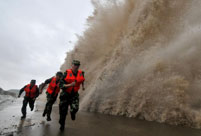Sanjiangyuan, the origin of China's three major rivers, has and will continue to become warmer and wetter as a result of global warming, latest monitoring data showed.
The headwaters area, on the remote Qinghai-Tibet Plateau which normally features dry and cold weather, has seen its temperature rise 1.98 degrees Celsius and increasing rainfall between 1961 and 2012, said Li Lin, a senior engineer with Qianghai Provincial Meteorological Bureau.
The average annual temperature rise in Sanjiangyuan during this period is higher than the national and global average, said Li, citing an advisory report on climate change policies, based on a survey carried out by the bureau.
Statistics suggested the area has experienced more heat waves and fewer extreme cold days over the past five decades, Li said.
Due to the rising temperature, the maximum depth of permafrost in the headwaters area has decreased on average by 12 centimeters every 10 years and most of the glaciers there are melting, he said.
The report predicted that by 2100 the temperature in Sanjiangyuan will have risen 3 degrees Celsius from now. It said an increase of 1.1 degrees Celsius means 19 percent of the permafrost would thaw.
The report estimated that glacial areas in the region may shrink by 40 to 60 percent by 2100.
"Many drivers complain that roads have become more bumpy in recent years. The reason is permafrost degradation, it has caused roads to sink," said Wu Guolu, head of the provincial environmental and geological prospecting institute.
Experts believe climate change is a double-edged sword for the country's "water tower," the source of the Yangtze, Yellow and Lancang rivers.
Retreating glaciers fail to reflect light from the sun and therefore may lead to temperature rises and trigger more evaporation, which is likely to accelerate desertification, according to Xin Yuanhong, another senior geological survey engineer in Qinghai.
Li said melting ice has also disrupted the balance of water resources in east Asian rivers, sparking safety concerns.
Monitoring results showed several major lakes in Hoh Xil, the world's third largest unpopulated area on the plateau, has been expanding since 2011, threatening the Qinghai-Tibet railway and road network.
In addition, more frequent rainstorms and blizzards have wreaked havoc on people's lives, Li said.
However, experts said a silver lining could be that increasing rainfall in the next 50 years may benefit barren highlands and farming, a local pillar industry.
In 2012, forest coverage in Sanjiangyuan rose 2.1 percent year on year, according to Li.
China established the Sanjiangyuan Nature Reserve in 2000, hoping to repair the fragile ecological system. Five years later, it launched a 7.5-billion-yuan (1.2-billion-U.S. dollars) ecological conservation project in the region.
2013 is the final year of the nine-year project, which involves the relocation of 50,000 people, mostly Tibetan herdsmen, as well as clean energy development and the reclamation of cropland.
 2013 Colour Me Rad 5K run held in Canada
2013 Colour Me Rad 5K run held in Canada China's destroyer Qingdao sails out of Sydney Harbor
China's destroyer Qingdao sails out of Sydney Harbor Chinese tycoon aims to restore London's Crystal Palace
Chinese tycoon aims to restore London's Crystal Palace A staple of southern Chinese people
A staple of southern Chinese people Typhoon Fitow approaches China
Typhoon Fitow approaches China Tourists take pictures beside Qinghai Lake in Xining
Tourists take pictures beside Qinghai Lake in Xining New couples take wedding photos during holiday
New couples take wedding photos during holiday Serena Williams stumbles through to quarterfinals
Serena Williams stumbles through to quarterfinals Thailand Mobile Expo 2013 kicks off
Thailand Mobile Expo 2013 kicks off Photo collection of Chinese Navy
Photo collection of Chinese Navy Dense haze envelops N China
Dense haze envelops N China Twins Culture Festival kicks off in Beijing
Twins Culture Festival kicks off in Beijing UNESCO world heritage site: Montale Tower
UNESCO world heritage site: Montale Tower Egyptian protesters clash with police amid war anniv. celebration
Egyptian protesters clash with police amid war anniv. celebration Serena Williams wins second China Open title
Serena Williams wins second China Open titleDay|Week|Month